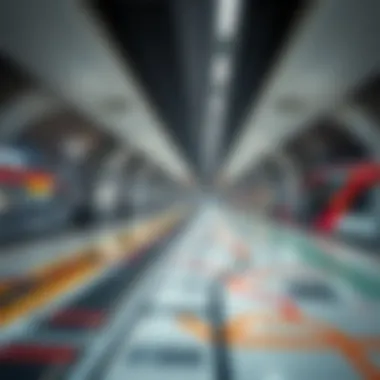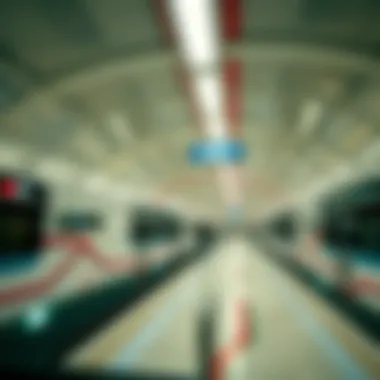Exploring Dubai's Metro Red and Green Line Map


Intro
Dubai’s Metro system is a marvel of urban engineering and a vital component of the city’s infrastructural framework. As travelers glide silently along the tracks of the Metro Red and Green Lines, they experience not just a means of transport, but also a glimpse into the very fabric of the city’s neighborhoods and real estate landscape. The intricate network allows both residents and newcomers to traverse from one end of the city to another with remarkable ease. In understanding how these metro lines operate, investors, expats, agents, managers, and buyers can better navigate not only their daily commutes but also the opportunities present in Dubai's rapidly evolving property market.
The Metro Red Line connects key districts, offering a direct route through landmark areas such as Dubai Marina, Jumeirah Lake Towers, and the famed downtown area, where the Burj Khalifa stands proud. On the other hand, the Green Line weaves through areas rich in culture and history, including Al Qusais and Al Hudaiba, providing access to many vibrant neighborhoods that are traditionally less explored by tourists. Together, these lines form the backbone of public transportation in Dubai, shaping urban development and influencing local real estate dynamics.
By diving deeper into the operational aspects and strategic relevance of these lines, we unearth vital insights into the shifting investment landscape. This exploration goes beyond mere logistics; it highlights how the metro facilitates growth, connects communities, and provides a path for real estate ventures.
Understanding the relationship between the Metro system and property investments is crucial, as accessing well-connected areas can dramatically enhance property values. The sections that follow will delve into the current market trends and future predictions, as well as the types of investment properties available and the financing options that can make these ventures feasible.
Prolusion to the Metro System
The Metro system in Dubai is not just a transportation network; it acts as a vein through which the city's pulse beats. Understanding this system is foundational for anyone looking to navigate, invest, or dwell in this rapidly developing modern metropolis. With two prominent lines—the Red and the Green—Dubai's Metro serves as a lifeline, connecting people from all walks of life while playing an integral role in the urban landscape.
From its inception, the Metro was envisioned as a solution to the burgeoning traffic woes and urban sprawl that Dubai faced. It's designed to facilitate mobility, reduce reliance on cars, and promote a sustainable environment. Understanding the Metro system is also about grasping how it intersects with real estate opportunities, enabling investors and expats to make informed decisions about where to live and work. Not only is it about hopping onto a train; it's understanding the lifestyle that surrounds each route.
History of Dubai's Metro
The journey of Dubai's Metro began in the early 2000s when visionary leaders recognized the need for an efficient public transport system in a city poised for exponential growth. Construction started in 2006, and just four years later, in 2010, the first line commenced service. It was an ambitious endeavor marked by technological innovations and architectural marvels.
One of the landmarks of its history is the development of the Red Line, running 52 kilometers from Rashidiya in the northeast to UAE Exchange in the southwest. This line was the first of its kind in the region, showcasing Dubai's commitment to modernity. The Green Line followed, extending the reach of the city’s transport options, strategically connecting neighborhoods that were previously isolated from the main urban hubs.
Dubai's Metro set standards for high-speed rail travel in the Middle East. It integrated advanced safety systems and offered a lavish riding experience, including fully automated trains and air-conditioned stations. Such developments set the stage for future expansions and upgrades, positioning the Metro as a model for developing nations.
The Significance of Public Transport
Public transport in any city serves as a foundation for economic vitality and social interaction. In Dubai, the Metro has effectively transformed how residents and visitors traverse the emirate. It provides an cost-effective alternative to private vehicles and alleviates congestion on roadways, contributing to lower pollution levels.
The existence of a robust public transport system can also magnify the value of local neighborhoods. Areas around metro stations tend to see increased foot traffic and improved business opportunities. With the Metro giving easy access to shopping malls, cultural landmarks, and residential areas, these zones become prime targets for real estate investment. This accessibility is essential for investors seeking vibrant neighborhoods with growth potential.
Moreover, public transport fosters inclusivity. It’s designed to cater to all citizens and tourists, simplifying logistics for those who might not drive. Understanding this significance is imperative for anyone interacting with Dubai's property market. As Dubai continues to expand its horizons, the Metro remains a cornerstone for linking urban elements together.
"An efficient public transport system is the backbone of urban life, sustaining not just movement, but the economy and social fabric of a city."
For more on Dubai's Metro, refer to Wikipedia or explore detailed city planning analyses at Britannica.
The growth and integration of the Metro into Dubai’s daily life not only demonstrate effective urban planning but also reflect the emirate's ambitions. Understanding these elements helps us comprehend how Dubai has arrived at its current state of progress and opportunity.
Overview of the Red Line
The Red Line of Dubai’s Metro is more than just a series of train stops; it is a vital artery connecting various parts of this bustling city. Understanding the Red Line goes beyond knowing its route; it involves recognizing how it plays a key role in shaping the urban landscape and influencing real estate dynamics. As investors and prospective buyers assess the vibrancy of different neighborhoods, the importance of the Red Line comes sharply into focus. The line serves both locals and visitors, providing access to main attractions and commercial hubs, which fosters growth and investment opportunities.
Key Stations along the Red Line


The Red Line features a number of key stations, each significant in its own right.
- Union Station: This station is a crucial interchange point, linking the Red Line with the Green Line. It's located in the heart of Dubai, making it a bustling hub for commuters and travelers alike.
- Burj Khalifa/Dubai Mall: One cannot overlook the proximity of this station to the iconic Burj Khalifa and the lavish Dubai Mall. It draws a steady flow of tourists and local shoppers, making it a prime spot for businesses looking to capture high foot traffic.
- Deira City Centre: Serving as a major retail destination, this station caters to those balancing shopping outings with daily commutes. Its impact on local commerce cannot be understated.
- Dubai Marina: A notable station that connects to a residential area, it captures the essence of luxury living, which appeals to buyers and investors alike.
Each of these stations is strategically placed, reflecting the metropolitan growth and catering to diverse demographics.
Connecting Areas of Interest
The connectivity offered by the Red Line makes it a facilitator of interaction between various important locales. From cultural sites to financial centers, the Red Line embraces a plethora of interests, ensuring that residents and tourists can effortlessly navigate Dubai. The trains run seamlessly through key neighborhoods, such as:
- Jumeirah Lakes Towers: Known for its skyscrapers and vibrant lifestyle, this area benefits greatly from its accessibility via the Red Line.
- Business Bay: As a growing hub for business and trade, the proximity of this district to the Burj Khalifa ensures that both professionals and tourists have easy access to the area.
- Palm Jumeirah: While not directly on the Red Line, the ease of access from nearby stations allows residents to commute without hassle, boosting property desirability in that area.
This network not only enhances the residents' daily commute but serves as a card-carrying ticket for more extensive exploration of Dubai’s rich tapestry of life.
Impact on Real Estate Values
Understanding the Red Line is pivotal for anyone evaluating real estate opportunities in Dubai. The line’s impact on property values is quite profound. Areas within a short walk from Red Line stations typically see higher property values.
- Value Appreciation: Properties adjacent to Red Line stations often appreciate more than those further away. Accessibility is a critical factor, drawing tenants and buyers alike who prefer the convenience of public transport.
- Increased Demand: As the metro system expands and becomes more integrated, neighborhoods served by the line often experience a jump in demand. New residential developments sprout, catering to families, young professionals, and international expats looking to settle in vibrant areas.
Understanding the Green Line
The Green Line of Dubai's Metro system serves as a vital artery for those navigating the bustling urban landscape. It offers essential connections to numerous neighborhoods, cultural hubs, and commercial centers, shaping the daily lives of countless residents and visitors. As the city continues to expand, understanding the Green Line's significance is not just beneficial; it is essential for anyone keen on grasping Dubai's ever-evolving real estate and urban fabric.
The Green Line covers a wide range of areas, making public transport accessible for people from different walks of life. It runs parallel to the Red Line but slightly diverges in terms of served areas, making it an indispensable part of the overall transport network. Knowing the ins and outs of the Green Line can enhance accessibility and convenience, adding value to both personal travel and investment decisions.
Prominent Stations on the Green Line
The Green Line comprises various stations that each offer unique sights and sounds. Among the notable stops is Dubai Healthcare City, which brings together healthcare facilities and educational institutions, appealing to both working professionals and families. Next is Al Jaddaf, a neighborhood known for its waterfront lifestyle and cultural sites, like the Dubai Dragon Mart, attracting shoppers and casual strollers alike.
Another key station is Baniyas Square, located in the heart of the city, where diverse experiences from traditional markets to modern cafes await. This station not only links various areas but also integrates key commercial sectors, showing how strategic placement drives foot traffic. Overall, each station along this line serves as a gateway to different facets of Dubai's ambiance and lifestyle, making the Green Line a tour through the city's diverse neighborhoods.
Neighborhoods Served by the Green Line
The neighborhoods served by the Green Line showcase a dynamic range of living experiences, each with its own character.
- Deira: This older district boasts a traditional market scene, known for its spice and gold souks, giving residents a taste of history mixed with modernity.
- Bur Dubai: Characterized by heritage sites, parks, and a rich cultural tapestry, Bur Dubai is a hub for expats and Emiratis alike. The neighborhood is home to many expatriate communities, which offers a multicultural vibe.
- Satwa: Known for its diverse culinary offerings, Satwa presents flavors from around the world, reflecting Dubai's multicultural identity.
Each of these neighborhoods nurtures interaction among people, making the Green Line not just a transit route but a thriving connector of communities.
Effect on Local Property Markets
The Green Line has significantly influenced local property markets along its route. Housing developments and commercial properties have sprung up in response to the metro system's accessibility. Investors have noticed that properties within close vicinity of Green Line stations see enhanced demand, often leading to higher rental yields and property value appreciation.


For instance, developers are now focusing on areas near stations like Al Jadaf, where projects are being launched to cater to an increasingly mobile populace. The demand for homes and businesses in these areas often outstrips supply, creating lucrative opportunities for property investors. Additionally, as more residents opt for the convenience of commuting on the Green Line, areas adjacent to the stations stand poised for growth, further validating the correlation between metro access and escalating property values.
"The Green Line acts not just as a means of transport but as a catalyst for economic growth and urban development."
Resources:
Interchange Stations and Connectivity
Interchange stations play a pivotal role in the overall efficiency and usability of Dubai's metro system. They are the points where different metro lines meet, facilitating the seamless transfer of passengers from one line to another. This connectivity is essential for a city as expansive and rapidly developing as Dubai, where navigating through the various districts can otherwise become cumbersome.
Importance of Interchange Points
The value of interchange points extends beyond mere convenience. They act as gateway hubs, unlocking access to a wider array of destinations across the city. For instance, a passenger traveling on the Red Line only needs to make a quick switch at a key interchange station, such as Union or BurJuman, to access the Green Line. This not only saves time but also enhances the travel experience. The careful planning of these points has far-reaching implications:
- Enhanced Commuter Flow: Interchange stations are designed to manage high volumes of foot traffic, thereby ensuring a smooth transition for passengers.
- Time Efficiency: By limiting the number of transfers required, commuters can reach their destinations faster, making public transport a more attractive option compared to driving.
- Economic Activity: Many of these stations are strategically located near commercial, business, and residential areas, effectively boosting local economies by increasing footfall in those regions.
- Tourist Attraction: Tourists can easily explore multiple areas without the need to familiarize themselves with the entire metro system, fostering increased tourism in attractions along the metro route.
Interchange stations offer an essential link in public transport, fostering economic growth and enhancing urban mobility.
Enhancing Accessibility Across Dubai
Interchange stations don’t just benefit commuters; they enrich the urban landscape by enhancing accessibility across the emirate. The careful positioning of various interchange points allows districts that were once considered remote to connect effortlessly with central business districts and major tourist spots. The benefits of increased accessibility include:
- Improved Reach: People residing in outlying neighborhoods can easily access downtown Dubai and other vibrant areas, leading to more equitable development throughout the city.
- Real Estate Opportunities: Areas surrounding interchange stations often see a surge in property demand, as these locations become more desirable due to their connectivity. Investors may find that properties near key transit points hold better long-term value.
- Social Integration: Enhanced connectivity fosters a greater sense of community among residents of diverse neighborhoods, breaking down barriers and enhancing social cohesion.
- Environmental Impact: By promoting public transport use over personal vehicles, the city can reduce traffic congestion and lower carbon emissions, making it a more sustainable urban environment.
Metro Fares and Travel Trends
Understanding metro fares and travel trends isn't just a matter of numbers; it's about deciphering how these elements blend into the fabric of Dubai's urban transportation landscape. Metro fares play a pivotal role in shaping the overall travel experience for residents and visitors alike, especially in a bustling city where public transport offers a lifeline to various neighborhoods. Moreover, travel trends reveal patterns that can influence real estate investment strategies, making this section particularly significant for investors, expats, agents, managers, and buyers.
Fare Structure Overview
The fare structure for Dubai's metro is designed to be both simple and efficient, catering to a diverse populace. The fares are generally tiered based on the zones passengers travel through. Here’s a breakdown:
- Nol Card Types: There are several types of Nol cards, including the Red Card, which is ideal for tourists, and the Gold Card for those who wish to enjoy a more luxurious commuting experience.
- Pricing Tiers: Travel in one zone typically costs around 3 AED, whereas crossing multiple zones could range from 5 to 7.5 AED, depending on the distance covered.
- Discounts and Offers: The metro system also offers discounts for students, seniors, and people of determination, motivating these specific demographics to utilize public transport more frequently.
This structured approach not only makes it easy to understand the costs involved but also encourages more people to make use of the metro system rather than driving, which can congest the busy city roads.
Factors Influencing Travel Behavior
Several factors influence how and why individuals choose to travel via the metro in Dubai:
- Convenience and Accessibility: The easy connection between major commercial and residential areas greatly impacts people's choices. For example, having a station close to home can be a game-changer for daily commuters.
- Affordability: Compared to the alternative of owning a vehicle, metro fares remain competitive, particularly in a city where fuel prices and parking fees can add up quickly.
- Tourism Impact: Visitors to Dubai often rely on public transport to explore attractions. This trend not only boosts metro usage but also encourages investments in areas well-served by the transit system.
- Environmental Awareness: A rising awareness of environmental issues has led more individuals to prefer public transport over cars, valuing sustainability as a factor in their commuting habits.


In short, the metro isn't just a way to get from point A to B; it's part of a larger ecosystem that shapes daily life in Dubai.
Ultimately, the study of metro fares and travel trends offers valuable insight into the dynamics shaping Dubai's transportation framework. For investors and buyers, understanding these trends is essential for making informed decisions in the real estate market, especially as areas around high-traffic stations often see increased property values.
Vision for Future Extensions
Exploring the potential future extensions of Dubai's metro system sheds light on crucial facets relevant to both the city’s transit infrastructure and the real estate market. These extensions not only represent a commitment to enhancing public transport but also mirror Dubai’s aspirations for urban development in line with population growth and economic expansion.
Such initiatives encourage investment and development in areas that may otherwise be overlooked. A well-connected metro system enhances accessibility, which in turn makes neighborhoods more appealing to investors and residents alike. Furthermore, future extensions allow for strategic urban planning that supports sustainable growth, potentially reducing traffic congestion and acting as a catalyst for new businesses.
While these planned expansions promise numerous benefits, they also warrant careful consideration. Stakeholders must assess environmental implications and community needs, ensuring that development does not skew toward profit margins at the expense of environmental sustainability or social cohesion. Successful metro extensions require collaboration among city planners, developers, and the community, balancing growth with the need for quality living conditions.
Future metro expansions will not only tie together existing neighborhoods but also open up new areas, creating opportunities for real estate projects that resonate with a growing population.
Proposed Line Extensions
The proposed line extensions aim to bridge gaps in the existing metro map and expand the transportation framework across Dubai. Among the noteworthy proposals includes extending the Red Line toward the Al Maktoum International Airport. This extension is significant as it would allow easier access for travelers and create a rapid transit option for those commuting to Dubai’s burgeoning travel hubs.
Another highlight is the extension of the Green Line towards neighborhoods like Dubai Marina and Jumeirah, where luxury residences and entertainment options abound. Connecting such affluent areas is not only smart transit planning but also likely to appeal to high-value investments in real estate.
Potential line expansions will likely encourage developers to invest in new mixed-use projects, enhancing public and private space interaction.
Some developments aim to create a circular metro that connects various lines, effectively forming a backbone for public transport across the city. Such connectivity could further stimulate local economies by improving access to goods and services in previously distant districts.
Projected Impact on Real Estate Development
Anticipated metro extensions offer a ripple effect on real estate development strategies in Dubai. As regions gain direct access to the metro, property values often see an uptick. Research indicates that proximity to metro stations can increase property prices by as much as 15-25% in certain neighborhoods. Investors keen on the market must note this correlation between transport accessibility and real estate value escalation.
- Key impacts on real estate include:
- Increased demand for residential properties: More accessible transport options can help attract buyers.
- Enhanced commercial developments: Businesses often flourish near transit stations due to foot traffic, with local shops, restaurants, and service providers seeing growth.
- More vibrant community habitats: Areas formerly known for quiet or less-trafficked locations could grow to become bustling neighborhoods with parks, cafes, and cultural hubs, luring families and young professionals alike.
The potential for these extensions significantly shifts investment strategies. Foreseeing neighborhoods on the rise, many savvy investors might seek to capitalize on developing properties in catchment areas of future metro stations.
In summation, as plans solidify for the future of the Dubai Metro, both investors and residents can look forward to a redefined city landscape that prioritizes connectivity and community, making the prospect of living and working across the emirate more appealing than ever.
Finale
By examining the layout and connectivity offered by these lines, investors gain insights into key neighborhoods poised for growth. The strategic positioning of stations often correlates with rising property values, making it crucial for potential buyers or investors to grasp these connections effectively.
Moreover, the effectiveness of public transport is vital for expats, managers, and real estate agents as they navigate the various districts of Dubai. The ease of access provided by the metro allows for a wider reach in terms of property options. Greater accessibility translates to increased footfall, which can benefit commercial investments significantly.
Key Takeaways:
- Public Transport as a Development Driver: The metro lines are not just about getting from point A to point B; they're integral to the city's planning and growth trajectory.
- Focus on Connectivity: Understanding which neighborhoods are connected through the metro can help in identifying investment hotspots.
- Impact on Residential and Commercial Markets: Properties near metro stations typically see increased demand due to the convenience of transport.
Investing time to understand the metro’s structure and operations can significantly benefit anyone involved in Dubai’s real estate market. These insights not only empower better decision-making but also enhance appreciation for the city’s ongoing evolution.
"A city's public transport system is a window into its soul, reflecting its ambitions, opportunities, and connectivity."
For futher details, you may find useful information on Wikipedia, or dive into community discussions on Reddit to hear local perspectives. This knowledge can enhance your strategic approach in navigating Dubai’s ever-evolving landscapes.











